Fish and Shellfish Stocks 2012
Fish and Shellfish Stocks 2012. State of Scottish fish stocks, TACs and biology of the stocks for 2012.
SCALLOP
Latin name :
Pecten maximus
Common names : Great scallop, King scallop, Clam, Coquille
St. Jacques
Introduction
The King scallop is the second most valuable shellfish species in Scotland. Landings into Scottish ports in 2010 of 9,000 tonnes were worth £17.6 million and made up just under a third of the UK total. The commercial fishery for scallops in Scotland started as a seasonal fishery in the Clyde during the early 1930s, and developed rapidly during the late 1960s and early 1970s, expanding to other west coast grounds. Fisheries around Shetland and in the Moray Firth also developed over this period, followed by fisheries off the east coast of the Scotland in the 1980s. Nowadays, fishing takes place all year round. Most scallops are caught using arrays of specialized dredges attached to bars towed from either side of the vessel. The scallop fleet comprises small vessels that tend to work locally in inshore waters and some larger vessels, up to about 30 m in length, which are capable of fishing grounds around Scotland and the rest of the UK. Scallops are also fished commercially by divers; dive caught scallops accounted for about 5 % of the landings in 2010.
Scallop landings (tonnes) by UK vessels into Scotland, 1974 -2010
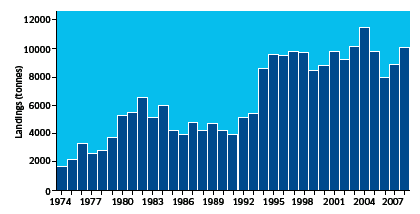
Biology and life cycle
Scallops are bivalve molluscs that live in the waters around Scotland and the wider northeast Atlantic coast. They can be found on the sea bed anywhere from just below the low water mark to depths exceeding 100 m, preferring sediments comprised of sand, gravel and mud, sometimes interspersed with stones, rocks or boulders. They are active suspension feeders, which rely on phytoplankton and suspended detrital material as their food source. If undisturbed, scallops usually lie recessed into the sediments with their flat valve uppermost, often covered by a layer of sediment with only their eyes and tentacles visible when the valves are open. They have numerous eyes around the shell margin. Each eye is capable of forming an image which, along with other well developed sense organs, make scallops highly sensitive to changes in their immediate surroundings. Although considered sedentary, scallops are able to swim limited distances propelled by jets of water. The jets are produced by rapid closure of the valves and can be redirected to aid recessing.
Scallops are hermaphrodites and release male and female gametes separately into the surrounding water. Spawning is synchronized with scallops nearby which improves the chances of successful cross-fertilization. Fertilised eggs develop over a period of 24 to 48 hours into free-swimming larvae that migrate towards the sea surface, spending three weeks or more in the water column. Larvae eventually settle on to the seabed, often becoming attached to the substrate, before undergoing final metamorphosis into the adult form. Larvae are affected by water circulation, tides and wind driven currents when they are near the surface. This makes it very difficult to predict where they eventually settle, which may be some distance from the parent population. In Scottish waters, scallops spawn for the first time in the autumn of their second year, and subsequently each year in the spring or autumn. After settlement, scallops grow until their first winter during which growth usually ceases. Thereafter, growth resumes in spring and ceases in winter causing distinct rings to be formed on the external surface of the shell. These annual growth rings can be used to determine the age and growth rate of scallops. In biological terms, the length of a scallop is the maximum dimension parallel to the hinge. In Scottish waters, scallops grow to lengths exceeding 175 mm, and can live for 20 years or more. Environmental factors such as water temperature and food availability affect growth rates, which vary between areas.
Management
For scallops current EU legislation specifies a minimum landing size of 100 mm length except in the Irish Sea where the limit is 110 mm. There are no limits on landings in the form of TACs or quotas. Under the Western Waters effort regime (which applies to all UK waters except the North Sea), effort limits are applicable to all vessels 15 m and over in length, including those fishing for scallops. The limits for UK scallop vessels are 1,974,425 KW days for Sub-areas V and VI and 3,315,619 KW days for Sub-area VII.
Recessed scallop
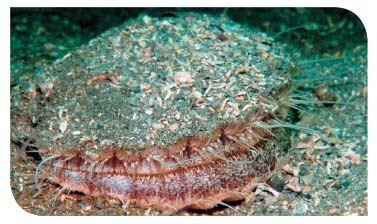
Scallop swimming behaviour
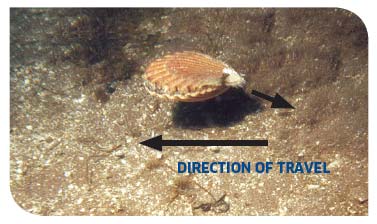
In Scotland, additional management measures specific to the scallop fishery have been introduced to support sustainable exploitation. In 1999, a restricted scallop licensing scheme was introduced in response to concerns about the expansion of scallop fishing effort. The scheme was strengthened in 2003 by gear restrictions that vary according to where fishing takes place: a maximum of 8 dredges per side can be towed in Scottish inshore waters (out to 6 nautical miles); a maximum of 10 per side in any other part of the UK territorial sea adjacent to Scotland (out to 12 nautical miles); and 14 per side in any other part of the Scottish zone (out to 200 nautical miles). Additionally, the use of "French" dredges (a design incorporating water deflecting plates and rigid fixed teeth) is prohibited in Scottish inshore waters.
Scallop assessment areas and landings (tonnes) in 2010
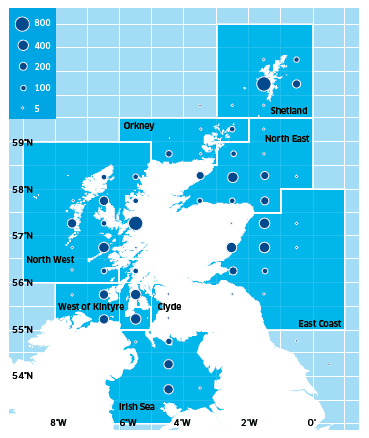
Assessment
For the stocks in the main scallop assessment areas: West of Kintyre, North West, Shetland, and North East, an aged structured method, Time Series Analysis ( TSA) is used. The TSA uses reported landings data, age and length frequency data collected as part of the Marine Scotland Science ( MSS) market sampling programme and catch at age data from the annual MSS scallop dredge surveys which are conducted around the coast of mainland Scotland and Shetland. The approach is an improvement on methods previously used to assess scallop stocks and is considered more robust in that it makes use of multiple data sources and can cope with the omission of poor quality or missing data. It provides annual estimates (with confidence intervals) of yield, fishing mortality, spawning stock biomass and recruitment. For the East Coast assessment area the survey catch rate data are the main source of information on stock dynamics. Stocks in the Irish Sea, Orkney, and the Clyde are not routinely surveyed and there are insufficient data for TSA - official landings and market sampling data are monitored.
Assessment areas and SSB / recruitment levels, 2005-2007
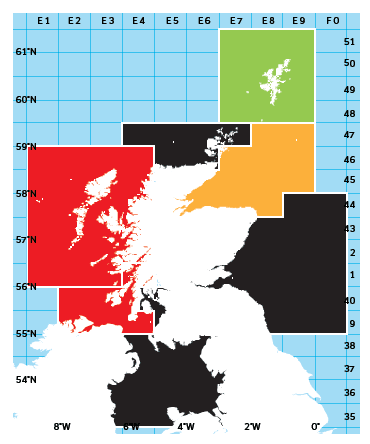

State of the stocks
The latest assessments were conducted in 2011, using data collected up to and including 2010. For those stocks with analytical assessments, the summaries below show catch (data and model estimates) and spawning stock biomass ( SSB) in thousand tonnes of scallop muscle, recruitment at age three in millions and annual fishing mortality averaged over ages four to six, as estimated by the TSA model. For the East Coast, the summary shows mean standardised trends in SSB and recruitment at age three as estimated from the dredge survey data.
West of Kintyre: The continued high catches and only moderate recruitment during the mid 2000s have resulted in a declining SSB which in 2010 reached the lowest level estimated over the 30 year time series. Estimated fishing mortality (F) more than doubled between 2006 and 2010, although the estimates of F in the most recent years are relatively uncertain.
North West: Following a period of high recruitment in the late 1990s and early 2000s, recruitment has declined and has been below the long term average since 2006. As a result SSB has also declined from the relatively high levels of 10 years ago. Catches have been low in recent years and this is reflected by the low fishing mortality.
North East: Fishing mortality in this area increased rapidly during the late 1980s and early 1990s. In the last five years it has been more stable, but with significant uncertainty surrounding the estimates throughout the time period. SSB has declined slightly in recent years after a period of relatively stable/increasing SSB since the mid 1990s.
Shetland: Fishing mortality on the stock around Shetland is estimated to have increased substantially in 2010 to the highest value in the time series. Recruitment has been fairly stable in recent years at around the long term average for the time series. SSB has been stable since the mid 2000s at above average levels.
East Coast: Stock trends as estimated from the dredge survey data suggest that SSB increased during the 2000s as a result of a number of strong year classes. However, recruitment in the last four years appears to have been low and SSB has been declining since 2008.
West of Kintyre stock summary showing catch and SSB of scallop muscle (000 t), recruitment at age three (millions) and annual fishing mortality averaged over ages four to six.
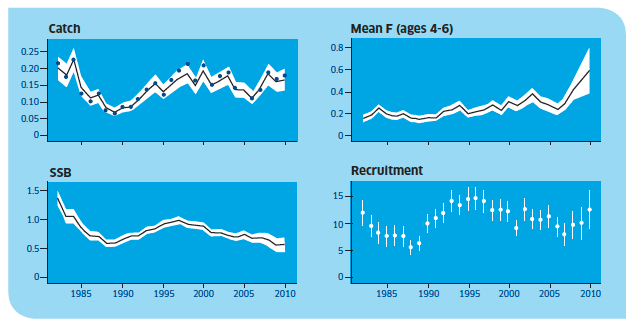
North West stock summary showing catch and SSB of scallop muscle (000 t), recruitment at age three (millions) and annual fishing mortality averaged over ages four to six.
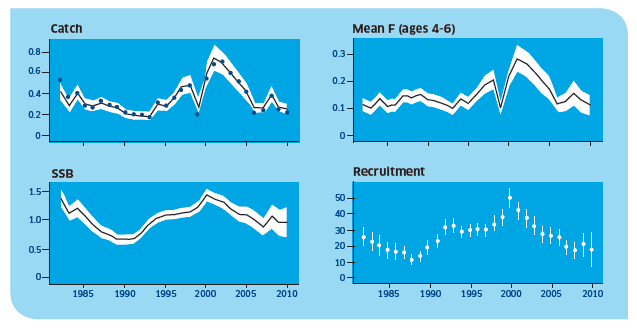
North East stock summary showing catch and SSB of scallop muscle (000 t), recruitment at age three (millions) and annual fishing mortality averaged over ages four to six.
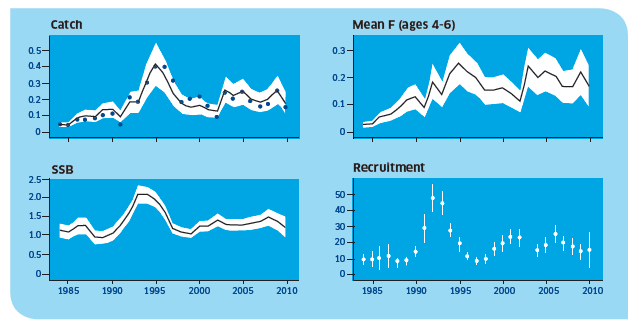
Management considerations
There are currently no agreed biomass or fishing mortality reference points for scallop stocks. MSS assessments indicate differences in stock dynamics in different assessment areas. In some areas increases in catches are associated with increased recruitment.
To the west of Scotland, SSB has declined markedly in the last ten years and recent estimates of fishing mortality for the West of Kintyre assessment area are high. Under these circumstances advice is for a reduction in fishing effort. Measures to increase spawning stock biomass should be considered. An increase in the minimum landing size has been proposed as a possible management measure for Scottish scallop fisheries. The survival of discarded scallops is high and therefore most undersized scallops returned to the sea have the potential to grow. This measure therefore has the potential to increase the reproductive capacity of the stock, provided that there is no associated increase in fishing effort.
In the North East and Shetland assessment areas, both SSB and recruitment appear relatively stable in recent years. Fishing mortality has been above the long term average. In such circumstances advice is for no increase in effort.
Shetland stock summary showing catch and SSB of scallop muscle (000 t), recruitment at age three (millions) and annual fishing mortality averaged over ages four to six.
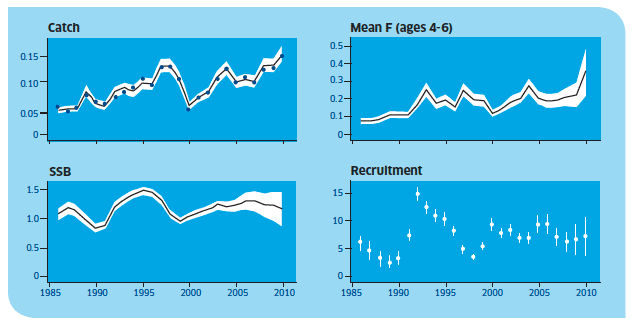
East Coast stock summary showing catch (000 t of scallop muscle) and trends in SSB and recruitment at age three (both mean standardised) from the dredge survey.
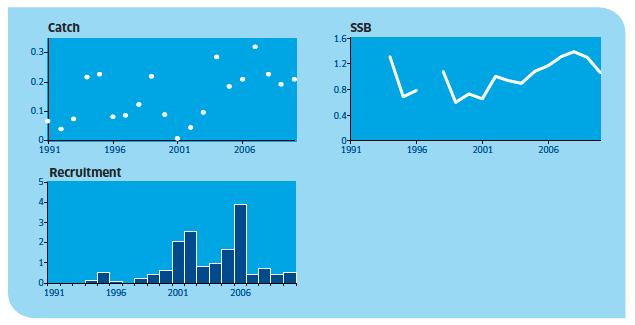
Contact
There is a problem
Thanks for your feedback